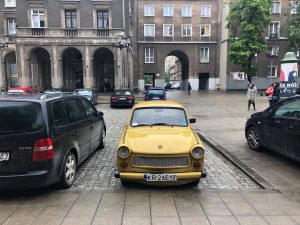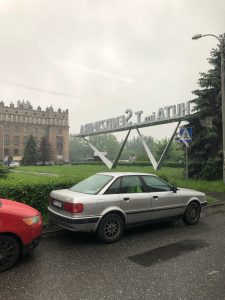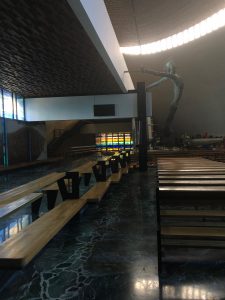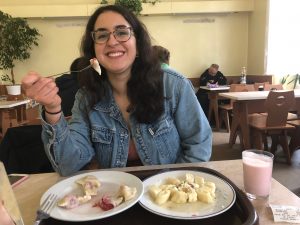



Walking through Nowa Huta is like entering a time machine. The city exemplifies history’s rule over modern life in Poland, as evidence of Stalinism is obvious everywhere, but the residents’ lives go on. Now knowing that reminders of World War II and communism are often inescapable for Poles, I wonder if the reminders are any more potent for residents of Nowa Huta than they are for Warsavians Warsaw’s history is memorialized in plaques, monuments, and museums on each corner, while Nowa Huta’s history is its existence as a Stalinist-planned city in itself.
Old is juxtaposed with new in very subtle ways. Among the modern cars parked around and driving through Nowa Huta are a few old Trabant cars. Trabant cars were produced between 1957 and 1990 and popularized during the communist era in Poland, which is why some remain with this in tact Socialist city. For the city of Nowa Huta to leave communism behind would mean destruction of the distinct Stalinist architecture that the city consists of. Slight changes and compromises are the city’s primary steps for disassociating with communism. The entrance sign was overtly associated with Stalinism, but now reads “Huta im. T. Sendzimira,” an edit that signifies exit from the era. The removal of the imposing, enormous Lenin statue at the center of town is indicative of the the city’s increasing independence from its founding ideologies. Presence of religion, particularly the church pictured above embodies breaking free from communism through and through. The structure of the building is emblematic of freedom, with wall and ceiling cascading like waves. Jesus’ posture and position is unique and falls perfectly in line with the structure of the church. On the edge of town, this church does not fit into the rest of Nowa Huta’s dark, intimidating architecture. I would like to see more details of change, or even resistance to communism, throughout Nowa Huta if I return.
Nowa Huta is still an active place, which was confirmed by our visit to the local milk bar. Here, Kaya kindly translated the menu and ordered food for us, as English was hardly spoken here (thank you, Kaya!). Jasmin and I shared strawberry pierogi z truskawkami (Polish strawberry dumplings, my favorite) and leniwe (a sweet Polish “gnocchi”). The milk bar was bustling with customers around lunchtime, primarily older residents bringing tupperware and jars for soups and other classic meals to store at home. As learned from our tour guide, Gosia, in the 60s and 70s as women entered the workforce, they had less time for home-cooked meals. Many would go to milk bars to get affordable, delicious Polish food, and apparently still patronize them with great frequency and enthusiasm.